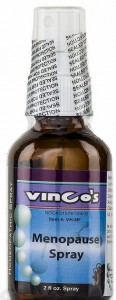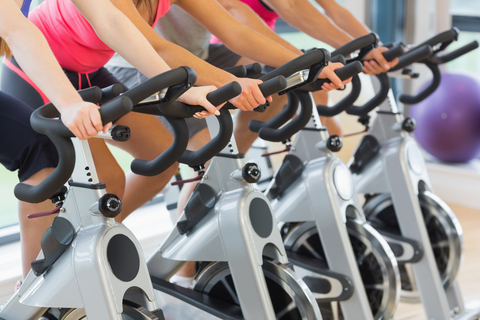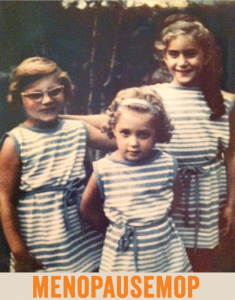To keep menopause at bay…
Just three sprays a day. Or something.
I ran across ‘Menopause Spray’ when I was researching this week’s blog posts. It is indicated for temporary relief of menopause symptoms. I hear that wine works just as well and it’s probably a lot tastier. 
Look, I am a HUGE fan of alternative strategies for treating the ‘pause. However, admittedly, I draw the line at homeopathic medicine. While many alternatives have been studied in scientific, controlled clinical studies, one of the main issues that I have with homeopathy is the lack of standardization among formulations. Still, homeopathy is delivered across Europe in both public and private healthcare systems. And, accordingly, many experts argue that when looking at thorough scientific reviews, the majority “do demonstrate more than placebo effects even when confined only to large number of high-quality trials,” adding that “ the clinical benefits of homeopathy cannot be explained by the hypothesis that homeopathy is ‘just a placebo’.”
According to an article published in Maturitas in August, 2010, the three basic tenets of homeopathy are that:
- Humans have a regulating mechanism responsible for growth and repair through which the homoeopathic remedy acts.
- Homeo (similar) pathos (suffering) encapsulates the law of ‘similars’ where the symptom picture guides the practitioner to a substance in nature which causes these similar symptoms. Provings (i.e. homeopathic investigative trials), toxicology and clinical cases give information about these homeopathic symptom pictures.
- Homeopathic medicines are ultra-dilute and these low doses reflect the body’s innate sensitivity to certain medicines.
The most important thing to remember when considering homeopathy as a therapeutic strategy is the approach; it’s not something you simply buy over the counter, but rather, it requires a careful, in depth consultation with a licensed practitioner who then considers your symptoms in totality and then matches the homeopathic medicines appropriately. In other words, like many treatments one size fits all simply does not work nor is it aligned with the basic philosophy of the practice. Which, gets us back to menopause spray. Following are the litany of ingredients, their strengths and what they are indicated for:
Lachesis Mutus 8X, 30X
- Climactic troubles
- Flashes of heat
- Palpitation
Helonias Dioica 6X
- Sensation of weakness
- Breasts swollen, nipples painful and tender
Sepia 12X
- Hot flashes with weakness and perspiration
Sanguinaria Canadensis 6X
- Flashes of heat
- Soreness of breasts
- Climactic disorders
Sulphuricum Acidum 12X
- Hot flashes, followed by perspiration with trembling
Lycopodium Clavatum 4X
- Weak memory
- Shakes head without cause
- Dryness of throat, without thirst
Kali Phosphoricum 6X
- Weak and tired
Amyl Nitrosum 30X
- Palpitation of heart
- Flushing of heat followed by cold and clammy skin and profuse sweat
Buyer, beware!!!
Read More
Newsflash! Can you slow down your biological aging?
 Researchers from King’s College in coordination with a European Union-funded project, EurHEALTHageing, are tracking biological aging by examining certain metabolites in the blood that they say act as ‘signposts’ for age-related diseases.
Researchers from King’s College in coordination with a European Union-funded project, EurHEALTHageing, are tracking biological aging by examining certain metabolites in the blood that they say act as ‘signposts’ for age-related diseases.
Consider this:
We age in two distinct ways. First, there is the aging by the calendar, so to speak, as we count the hours on the clock and the days and years in a calendar. However, there are also a host of diseases that can accelerate our clocks; this is what the researchers aim to focus on.
Granted, our genes play a huge role in aging, but the researchers explain that special chemical groupings that ‘cloak’ the genes can alter which specific genes are active at any given. This cloaking, known in scientific circles as ‘methylation’ is influenced by factors like diet, environment, exercise, pollution, etc and evidently affect whether or not we age faster or slower, healthy or not.
The ultimate goal is the ability to take a blood sample, analyze certain compounds and then determine the risks for developing certain diseases. Thereafter, there may be ways to counteract the biological process or at least, slow it down. Thus far, the researchers say that they have discovered 22 metabolites that are linked to age; and one in particular has caught their eye.
Meanwhile, take note: the Fountain of Youth might be ever so much closer!
Read More
Guyside: Chocoholic?
Oh, chocolate, you undo me.
I have a thing for chocolate. I love to eat it. Normally, this wouldn’t be a problem, right? Most people love chocolate. In the UK, people eat nearly 25 pounds of it every year. Here in North America, the average Canadian or US citizen eats lots less – about 11 pounds or so, but that’s still a lot.I figure if I quit, that average would go down by a pound or so.
With the gourmetization of everything, you’d think that this would be a good thing – consuming dark chocolate, with all those anti-oxidants and flavonoids is supposed to be good for you. But I have a taste – a craving – for the milky stuff. No nuts, no nougat, just good old milk chocolate. Perhaps it comes all the way from my childhood, when I used to have a big glass of Nestlé Quik for breakfast.
So when I think about how much chocolate I consume – bars, ice cream, gelato, etc. – I know that I’m consuming more of it than is likely healthy for me. Surely there are people out there that share this problem.
The key to me is that if I recognize this as a problem, then it is, at least for me.
So I decided to look for some tips to break this down a little bit, because I don’t necessarily want to go cold-turkey-total-abstinence-never-shall-chocolate-touch-my-lips-again. I want to be able to enjoy it in more moderation.
A Harvard medical blog suggests that if you note these three characteristics, then you’re behaving in an addictive way:
- intense craving
- loss of control over the object of that craving
- continued use or engagement despite bad consequences.
Chocolate, the post tells us, stimulates brain responses similar to those produced by “real” drugs. Now, I haven’t sold my body yet for a Hershey bar, but I don’t like the craving. And I don’t plan on entering a rehab program. So what do the big heads at Harvard suggest?
They focus on a mindfulness-related technique: “The next time you feel the pull of chocolate, pay attention to it. But instead of automatically reaching for your preferred candy bar or fudgy ice cream, take a few moments to actively decide whether or not to indulge the desire. If you decide to have chocolate, focus on each bite, slowly, to extend the pleasure in it. If you decide to wait, enjoy the notion that you’re taking good care of yourself. (You can take the same approach to alcohol, cigarettes, and food in general if you are trying to lose weight.)”
I’m gonna give this a try. What techniques do you use to control food consumption?
Read MorePhysical activity for prevention: how much, how often, how long?
Physical activity. You can’t beat it for preserving bone, maintaining weight and boosting endorphins and mood. Lord knows that there are reams and reams of data demonstrating its value. But confusion remains with regard to how much, how often and how long, i.e. what do you need to do to prevent physical and cognitive decline during menopause and thereafter?
A new systematic review of the literature appearing online in Menopause journal attempts to answer this very question. In it, the authors searched the literature published between the years 2009 and 2014 specifically as it related to physical activity and women’s physical and mental health and ultimately settled on 21 studies. The findings?
- In postmenopause, body composition and higher physical activity levels are associated with better physical functioning however, because frailty may actually begin in midlife, developing or maintaing a health lifestyle during the middle years is imperative.
- The higher the level of physical activity, the more significant the decrease in the odds of dying from any cause. Importantly, this remained true even after the researchers took into account factors like age, education, ethnicity, depression and comorbidities. Conversely, women who were more sedentary had a 98% higher risk of dying than their physically active peers!
- Exercises that improved cardiorespiratory capacity had the greatest impact on physical health. Cardiorespiratory capacity refers to the ability of the heart and lungs to deliver oxygen and remove CO2 to/from the skeletal muscles during physical activity. Here, higher is better. The question that remains unanswered is whether or not the prescription for cardiorespiratory boosting exercise change as we grown older?
- A key difficulty with activity is adherence. Consistently, women report that they abandon exercise due to time constraints, or personal, cultural or environmental factors.
- All of the studies found that physical activity was associated with lower rates of cognitive decline but the magnitude of this effect was inconsistent. Also unclear was the impact of physical activity on health-related quality of life.
The bottom line is that you need to MOVE, often, intensely and frequently. Do exercises that boost your cardiorespiratory capacity, e.g. jogging, running, swimming, cycling, kettlebells or interval training. And lose the excuses; make the time now or you’ll suffer later. It truly IS an either/or!
Read More
Mop this!
I receive solicitations regularly on Flashfree and to be honest, I turn down most of them. But I paid attention to this one because I liked the concept behind the product. What product, you ask?
The Menopause Mop, of course!
Look, I am not a huge fan of the name and for many women, it may provoke images of a sweaty, wet mop that never dries out no matter how many times it’s been wrung. However, when one of the three ‘Hot Flash Sistas sent me a note explaining that she and her siblings — all currently in their 50s and experiencing symptoms — started to experience hot flashes, they (and I) decided to get busy. She says that “the idea sprang from needing and wanting something attractive, functional and fun for women going through menopause.” Hence, the Menopause Mop was born.
Characterized as ‘neat, discreet and taking the heat,’ the Menopause Mop is really a 100% cotton handkerchief that is custom-sized for women and hand sewn by Cousin Sista Judy (a cousin who attended the Fashion Institute of Technology in NYC). It comes with a nifty little breathable mesh bag and can be easily accessed to dab away excess perspiration when you are feeling the heat. Even better, a portion of the proceeds from The Menopause Mop go toward supporting the Ovarian Cancer Foundation. The Mops appear to be reasonably priced at $15 and come in four colors: Orange Orange, Polka Dot Purple, Pretty in Pink and Gardeny Green.
Moniker aside, these three Sistas are trying to take off in the menopause space.
Mop this and show some love.
[Disclosure: I was not offered monetary or product compensation for this post. I simply like the idea and I love that they are giving back and paying forward.]
Read More







